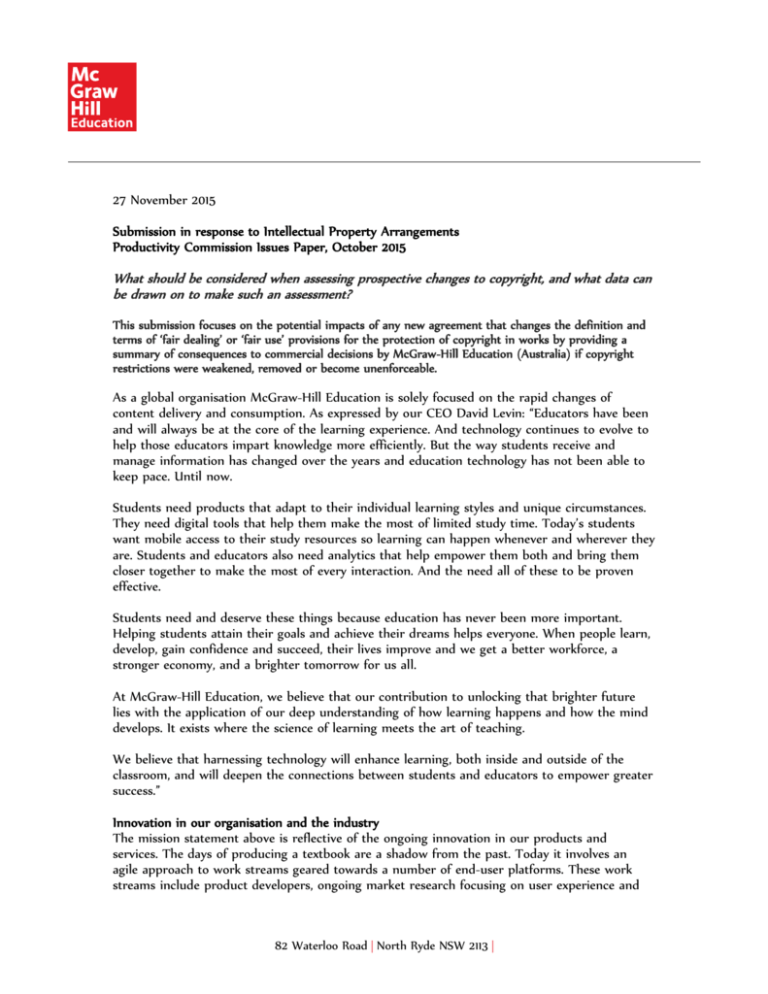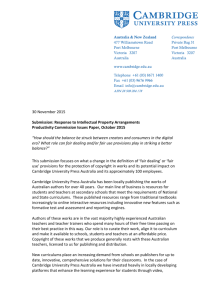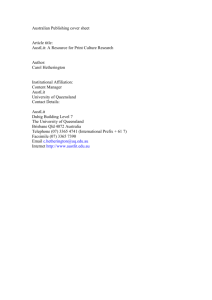Submission 14 - McGraw-Hill Education (Australia)
advertisement

27 November 2015 Submission in response to Intellectual Property Arrangements Productivity Commission Issues Paper, October 2015 What should be considered when assessing prospective changes to copyright, and what data can be drawn on to make such an assessment? This submission focuses on the potential impacts of any new agreement that changes the definition and terms of ‘fair dealing’ or ‘fair use’ provisions for the protection of copyright in works by providing a summary of consequences to commercial decisions by McGraw-Hill Education (Australia) if copyright restrictions were weakened, removed or become unenforceable. As a global organisation McGraw-Hill Education is solely focused on the rapid changes of content delivery and consumption. As expressed by our CEO David Levin: “Educators have been and will always be at the core of the learning experience. And technology continues to evolve to help those educators impart knowledge more efficiently. But the way students receive and manage information has changed over the years and education technology has not been able to keep pace. Until now. Students need products that adapt to their individual learning styles and unique circumstances. They need digital tools that help them make the most of limited study time. Today’s students want mobile access to their study resources so learning can happen whenever and wherever they are. Students and educators also need analytics that help empower them both and bring them closer together to make the most of every interaction. And the need all of these to be proven effective. Students need and deserve these things because education has never been more important. Helping students attain their goals and achieve their dreams helps everyone. When people learn, develop, gain confidence and succeed, their lives improve and we get a better workforce, a stronger economy, and a brighter tomorrow for us all. At McGraw-Hill Education, we believe that our contribution to unlocking that brighter future lies with the application of our deep understanding of how learning happens and how the mind develops. It exists where the science of learning meets the art of teaching. We believe that harnessing technology will enhance learning, both inside and outside of the classroom, and will deepen the connections between students and educators to empower greater success.” Innovation in our organisation and the industry The mission statement above is reflective of the ongoing innovation in our products and services. The days of producing a textbook are a shadow from the past. Today it involves an agile approach to work streams geared towards a number of end-user platforms. These work streams include product developers, ongoing market research focusing on user experience and 82 Waterloo Road | North Ryde NSW 2113 | customer insight, digital and technical platform managers and engineers. We find ourselves recruiting new talent from areas such that once were considered to be alien to the publishing industry, befitting the needs of the 21st century student and educator. However, intellectual property protection and value recognition remains the driving engine of this investment in innovation. It supports sustainable business practices that currently benefit both creators and consumers. License fees are a significant contributor to the revenue of McGraw-Hill Education and contribute to our ongoing investment in innovation. A change in the current copyright regime would endanger this innovation. Economic and societal impact Any revision to ‘fair dealing’ would impact the 100 employees currently employed, as well as the thousands of suppliers to our product and services. These suppliers are often sole traders and small businesses who are actively contributing to the knowledge economy and the productivity of the Australian economy through the education sector. Highly skilled creators such as authors, developers, subject matter experts, instructional designers rely heavily on their share of license fees which supplement lower royalty payments when students and teachers photocopy this content. Taking the Canadian experience from 2012, revisions to ‘fair dealing’ directly contributed to an unprecedented decline in Access Copyright revenue for McGraw-Hill Education in Canada, with the Schools division heavily impacted. There has been a subsequent loss of jobs and a shift to a US structure, damaging not only the local industry but by extension the publications of Canadian-specific cultural and curricula content. Education sector and the knowledge economy On a wider scale, changing the terms of ‘fair use’ could impact the Australian educational publishing industry and seems to contradict the government focus on AIE 2025. The Australian educational publishing industry supports the development of products and services that have made education a successful export contributor. The educational publishing industry plays an integral role in supporting the activities of the education sector by partnering in the provision of innovative and core print and digital resources to meet local curricula and cultural needs. This allows educators to devote more time to improving teaching and student outcomes, research and industry links, knowledge transfer, community participation and education leadership and administration. Our educational publishing industry supports the next generation of Australia’s working future through the school system, we assist in retaining the enviable position of Australia’s vocational and higher education sector in the international arena, and support professional lifelong learning for people to reskill and retrain in their chosen career paths. As a local academic and McGraw-Hill Education author of 20 years says “Valuing and protecting the intellectual capital of academics and authors is a fundamental premise of Australian higher 82 Waterloo Road | North Ryde NSW 2113 | education. It is important to recognise the learning and teaching contributions of local academics who create resources with professional and cultural relevance. Authoring tertiary texts helps our students to better understand course content, and succeed with their studies and career aspirations.” (August 2015) Changing ‘fair dealing’ potentially in favour of consumers would have a significant negative impact on Australia’s education sector at large. Diminished returns would reduce the ability of publishers to supply our valued and specific product and services that improve educational outcomes in Australia. Conclusion The basic recognition of the value of copyright protection through the current provisions is working well for both consumer and creator. Removing this entails unnecessary risk to a robust and productive system where educators depend upon the educational publishing industry for innovative, timely and quality content aligned to the standards or curriculum of the sectors. Teachers and students value the ongoing work of a myriad of highly specialised creators. In turn the educational publishing industry supports and rewards creators, of which license fees are a very substantial proportion of revenue stream. Removing photocopying license streams through potential new ‘fair use’ guidelines will cause significant harm to the financial and creative output of the educational publishing industry. To reiterate, this lessens the ability of the industry to innovate, to be a financially stable and productive contributor to the Australian economy, and to service and support the education sector and students. We respectfully implore our government to consider the ramifications of the proposed legislative changes in order to fairly represent and protect the interests and earning capacities of the many Australian stakeholders affected. Australia needs a vibrant and healthy knowledge economy, which is advanced by both education and innovation. Retaining revenue streams for fair use of intellectual property rewards innovation, and in turn, propels education. Cindy Jones Managing Director Southeast Asia, East Asia & Australasia 82 Waterloo Road | North Ryde NSW 2113 |







